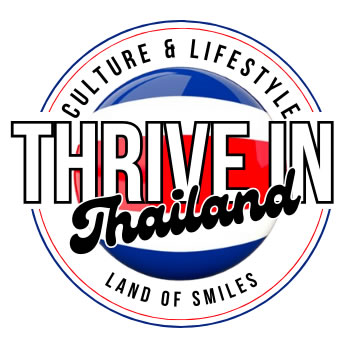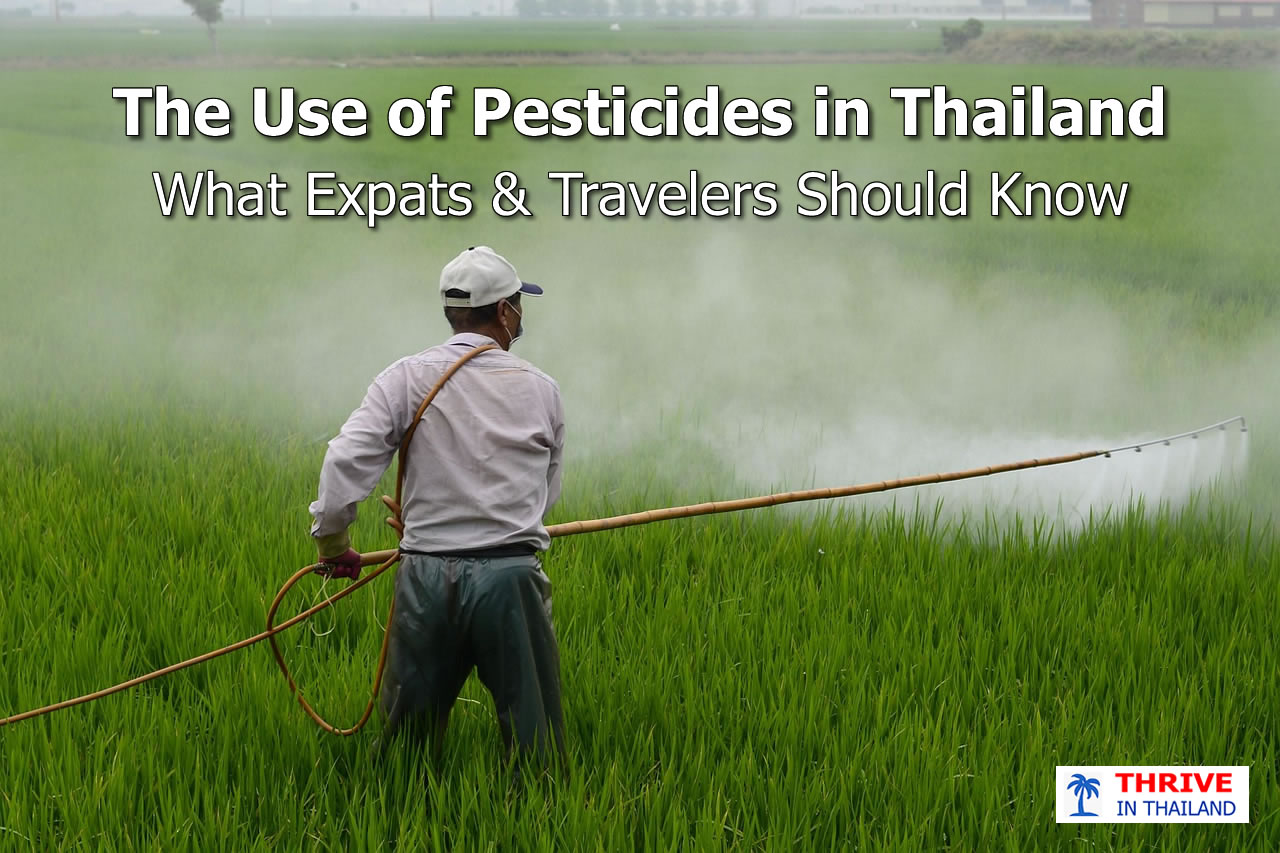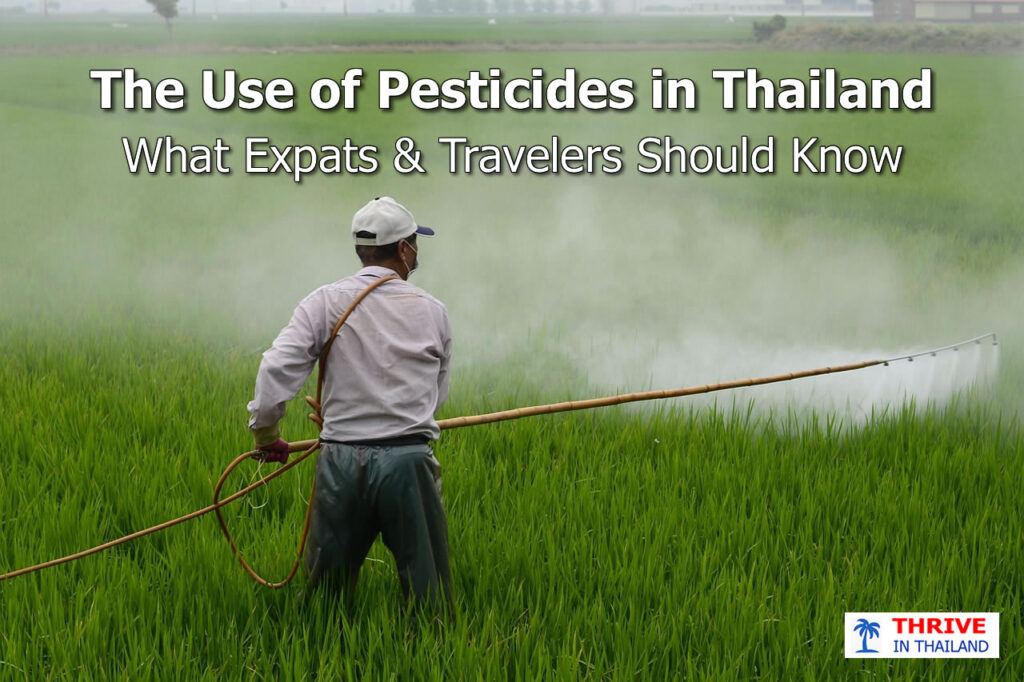
Thailand is often called the “rice bowl of Asia,” and for good reason. From the lush rice paddies of Isaan to the fruit orchards of Chanthaburi and the vegetable farms surrounding Chiang Mai, agriculture is woven into daily life here. But behind the abundance of fresh produce lies a more complicated reality: Thailand is also one of the heaviest users of pesticides in Asia.
For farmers, pesticides are a quick fix against pests and weeds. For consumers—locals, expats, and travelers alike—they raise important questions about food safety, health, and the environment. Some chemicals have been banned, others remain widely used, and residue testing often shows mixed results.
If you live here long-term, shop at local markets, or even just enjoy Thailand’s street food scene, understanding how pesticides are used and regulated matters. This guide takes a closer look at the big picture: health risks, environmental impact, government policies, and what practical steps you can take as a consumer in Thailand.
Pesticides in Thailand – The Big Picture
Agriculture is still the backbone of Thailand’s economy, with around one-third of the workforce involved in farming. To maintain high yields for both domestic consumption and export, pesticides have become a central part of modern Thai farming practices.
- High usage levels – Thailand imports roughly 100,000 tonnes of pesticides annually, putting it among the top pesticide users in Asia.
- Herbicides lead the way – The biggest share goes to weed killers, followed by insecticides and fungicides.
- Most affected crops – Rice, sugarcane, cassava, fruits (like durian, mango, and longan), and vegetables (especially leafy greens).
- Why so much? – Farmers face year-round pest pressure in Thailand’s tropical climate. Export standards push for “perfect-looking” produce, and cheap chemical solutions are often seen as more practical than labor-intensive alternatives.
📌 The sheer volume of pesticide use means that residues can turn up in food, water, and even the air near farming regions. It also sets the stage for ongoing debates about regulation, bans, and safer alternatives.
Pesticide Imports by Type in Thailand
| Type | Share of Total Imports | Common Uses |
|---|---|---|
| Herbicides | ~60% | Weed control in rice paddies, sugarcane fields |
| Insecticides | ~25% | Protecting fruits, vegetables, rubber trees |
| Fungicides | ~10% | Preventing mold/rot in fruit and rice storage |
| Other Chemicals | ~5% | Seed treatments, specialized pest control |
Health Risks for Farmers & Nearby Communities
Thailand’s tropical climate means pests are active most of the year, and many farms spray frequently. That puts farm workers, families, and people living near fields at the highest risk of exposure—through skin contact, inhalation, and contaminated water or dust.
Acute (Short-Term) Effects You’ll Actually See
- Skin/eyes: irritation, rashes, burning, conjunctivitis
- Breathing: cough, wheeze, chest tightness, shortness of breath
- Neurological: headaches, dizziness, nausea, confusion
- General: fatigue, sweating, muscle weakness
📌 These can appear within minutes to hours of mixing or spraying—especially when PPE is skipped or poorly fitted in hot weather.
Chronic (Long-Term) Concerns
- Neurological & cognitive: memory issues, sleep problems, mood changes
- Endocrine & metabolic: hormone disruption, possible fertility issues
- Organ damage: liver and kidney stress with repeated exposure
- Cancer risk: elevated risk has been associated with long-term exposure to certain pesticide classes in global studies
Who’s Most Exposed?
- Sprayers and mixers (highest dose from handling concentrates)
- Harvesters working soon after spraying (re-entry too early)
- Family members washing contaminated clothing or living near fields
- Children & older adults (greater vulnerability at similar doses)
How Exposure Happens (Common Pathways)
- Drift: droplets carried by wind to homes, schools, canals
- Residues: on crops, tools, clothing, motorbikes, and pickup beds
- Water: run-off into ponds, canals, and shallow wells
- Storage/mixing areas: poor ventilation, reused chemical containers
PPE Reality on Thai Farms
Even when PPE is available, it’s often too hot, uncomfortable, or incomplete (e.g., cloth masks instead of cartridge respirators). Gloves are skipped for dexterity, and boots for heat—leading to direct skin contact.
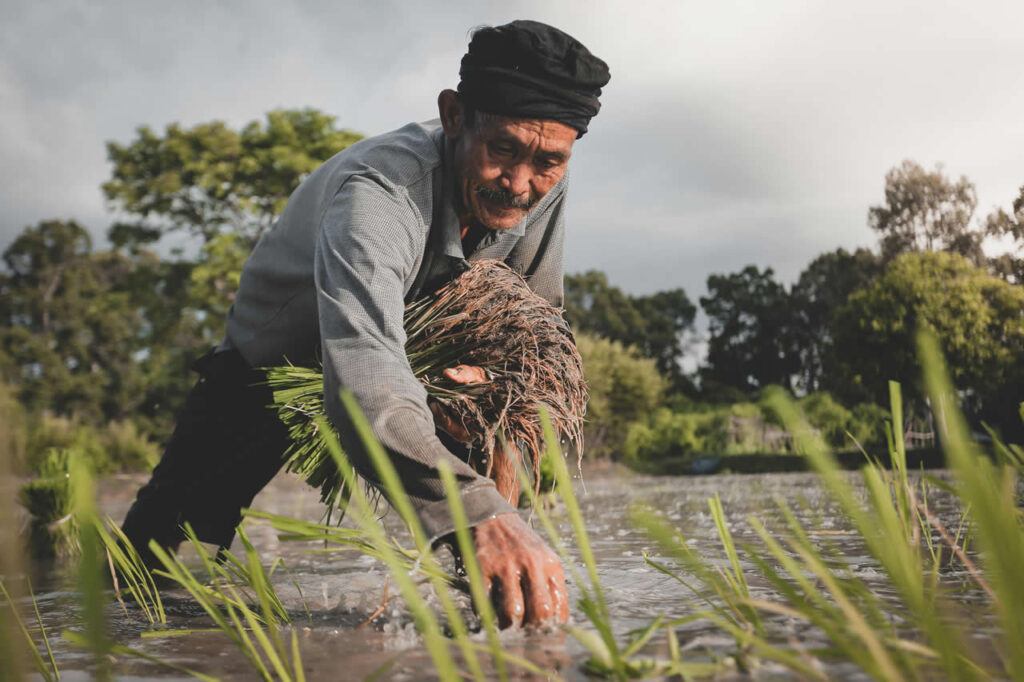
Practical Guidance (For Expats Living Near Farmland)
- Time your activities: avoid outdoor exercise during/just after spraying days.
- Water source: if you use wells or canals, consider filtration or testing; prefer municipal water where available.
- Home habits: keep windows closed during visible spraying; hose dust off patios and bikes; store shoes outside.
- Laundry: wash farm/work clothes separately and run an empty rinse cycle afterward.
- Gardening: if you buy sprays at local shops, read labels carefully, use gloves/eye protection, and never decant into drink bottles.
Food Safety & Consumer Risks
While farmers face the most direct exposure, pesticides don’t stay on the fields. They make their way into Thailand’s food supply chain, raising concerns for locals, expats, and international consumers alike.
Residues on Food
- Studies often find residues on fruits, vegetables, and rice, sometimes above international safety limits.
- Leafy greens, chilies, long beans, and guava are frequently flagged as high-risk produce.
- Even after washing, residues can remain—especially on crops sprayed close to harvest.
Market & Export Tensions
- Thailand is a major exporter of rice, seafood, fruit, and vegetables.
- When residues exceed EU or US limits, shipments face rejections or stricter inspections.
- This puts farmers in a tough spot: keep yields high for domestic markets or adapt practices for export compliance.
For Expats & Travelers
- Wet markets: fresh and cheap, but quality control varies. Pesticide residues are more likely in non-certified produce.
- Supermarkets: larger chains now carry organic or “safe produce” sections, often with GAP (Good Agricultural Practice) certification.
- Street food: generally safe, but vegetables used for garnish or salad can carry residues if not washed thoroughly.
Growing Demand for Organic
- Organic farms and cooperatives are on the rise, especially in Chiang Mai, Hua Hin, and Bangkok’s outskirts.
- Supermarkets like Tops, Villa Market, and Rimping now dedicate shelf space to organic Thai brands.
- While pricier, the shift reflects increasing consumer awareness about pesticide risks.
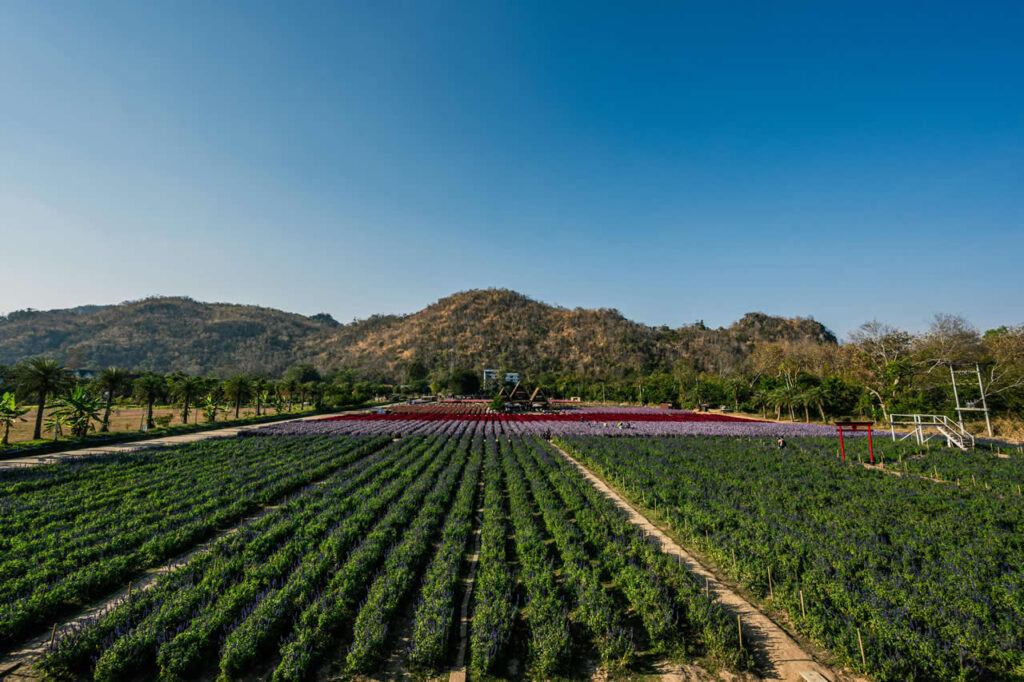
Where to Buy Safer Produce in Thailand
| Option | Pros | Cons |
|---|---|---|
| Wet Markets | Cheapest prices, freshest local produce, wide selection | Quality control inconsistent; higher risk of residues |
| Supermarkets | Safer sections (GAP-certified), refrigeration, convenience | Mid- to high prices; labels may be confusing |
| Organic Shops & Co-ops | Certified organic, strong community support, growing variety | Most expensive option; availability varies by city |
📌 Practical Tip for Expats: Peel where possible (cucumbers, mangos, papayas), wash leafy greens in a vinegar-water or baking soda solution, and look for GAP or organic labels in supermarkets.
Environmental Impact
Pesticides rarely stay where they’re sprayed. In Thailand’s monsoon climate and dense canal networks, chemicals can move quickly through soil, water, and food webs, with knock-on effects for ecosystems and nearby communities.
How Pesticides Spread in Thailand
- Runoff & canals: Heavy rains wash residues from fields into klongs (canals), ponds, and reservoirs, concentrating chemicals downstream.
- Soil carryover: Repeated applications can leave persistent residues that reduce soil biodiversity (earthworms, microbes) and affect nutrient cycling.
- Drift & dust: Sprays can drift onto neighboring plots, schools, or homes; dry-season field prep can kick up contaminated dust.
- Bioaccumulation: Aquatic insects, fish, frogs, and birds can accumulate certain chemicals over time, altering local food chains.
What’s Most at Risk
- Rice landscapes: Long, shallow paddies with shared irrigation make movement of chemicals easy between farms.
- Fruit & veg belts: Intensive spraying in vegetable zones (leafy greens, chilies, long beans) elevates local water and soil residues.
- Wetlands & mangroves: Sensitive nurseries for fish and crustaceans; even low doses can disrupt early life stages.
- Pollinators & beneficial insects: Broad-spectrum insecticides reduce bees, butterflies, and predator insects that naturally keep pests in check.
Why This Matters (Beyond Wildlife)
- Fisheries & farm ponds: Residues can lower fish survival and change species balance, affecting household protein sources.
- Algal blooms: Nutrient-pesticide interactions can tip water bodies toward blooms, reducing oxygen and harming fish. It’s one piece of a broader health puzzle that includes modern diet changes and rising obesity in Thailand—see Obesity in Thailand: Causes, Trends, and What Expats Should Know
- Resistance spiral: Overuse accelerates pest resistance, pushing farmers toward stronger or more frequent applications.
Practical Checks for Residents
- If you live near fields or canals, avoid swimming or fishing right after heavy rain or visible spraying days.
- Rinse balconies, patios, and outdoor gear periodically; keep window screens in good repair during spray seasons.
- For home ponds or kitchen gardens, consider buffer plants (banana, vetiver, lemongrass) and simple rain-runoff diversions to reduce inflow.
Legal Framework & Regulation
Thailand regulates pesticides under its broader Hazardous Substances Act (1992 and later amendments). Unlike some countries that have a dedicated pesticide law, Thailand treats pesticides as hazardous chemicals, which makes the rules complex and spread across several agencies.
Key Authorities
- Department of Agriculture (DOA): Handles registration, import approvals, and guidelines for use.
- Hazardous Substances Committee (HSC): Decides bans, restrictions, and risk classifications.
- Ministry of Public Health (MOPH): Oversees food safety standards and residue testing.
Current Legal Landscape
- Registration required: Every pesticide must be registered with the DOA before import, production, or sale.
- Classification: Pesticides are grouped into four hazard types (1–4), with Type 4 being the most restricted.
- Labeling: Products must carry Thai labels with hazard levels, use instructions, and safety precautions.
- Retail rules: Licensed dealers can sell pesticides, but enforcement is patchy—unregistered products are often available in rural supply shops.
Notable Bans & Restrictions
- Paraquat and Chlorpyrifos: Fully banned in 2020 after years of public health debates.
- Glyphosate: Initially set for a ban, later allowed with restrictions due to trade pressures.
- Other chemicals: Some highly toxic formulations are controlled, but enforcement is uneven.
Banned & Restricted Pesticides in Thailand
| Chemical | Status | Notes |
|---|---|---|
| Paraquat | Banned (2020) | Widely used herbicide; linked to Parkinson’s disease and acute poisoning |
| Chlorpyrifos | Banned (2020) | Insecticide associated with neurodevelopmental harm in children |
| Glyphosate | Restricted | Permitted under controlled conditions; subject of ongoing global safety debate |
| Atrazine | Restricted | Groundwater contamination concerns; tighter controls in sensitive areas |
Enforcement Challenges
- Weak monitoring: Random checks do not cover all markets; residues of banned pesticides still turn up in produce.
- Black-market sales: Old stock and illegal imports often circulate despite bans.
- Slow approval cycles: It can take years to update the registry, even when international agencies classify a chemical as hazardous.
📌 For Expats and Shoppers: Just because a pesticide is “banned” on paper doesn’t mean residues disappear immediately. Safer shopping habits—buying organic or GAP-certified produce—are still your best defense.
Farmer Practices & Social Factors
How pesticides are used on the ground in Thailand often comes down to cost, climate pressure, and habit. In a tropical setting with year-round pests, many farmers rely on quick chemical fixes to protect yields, with limited time or resources for training and protective gear.
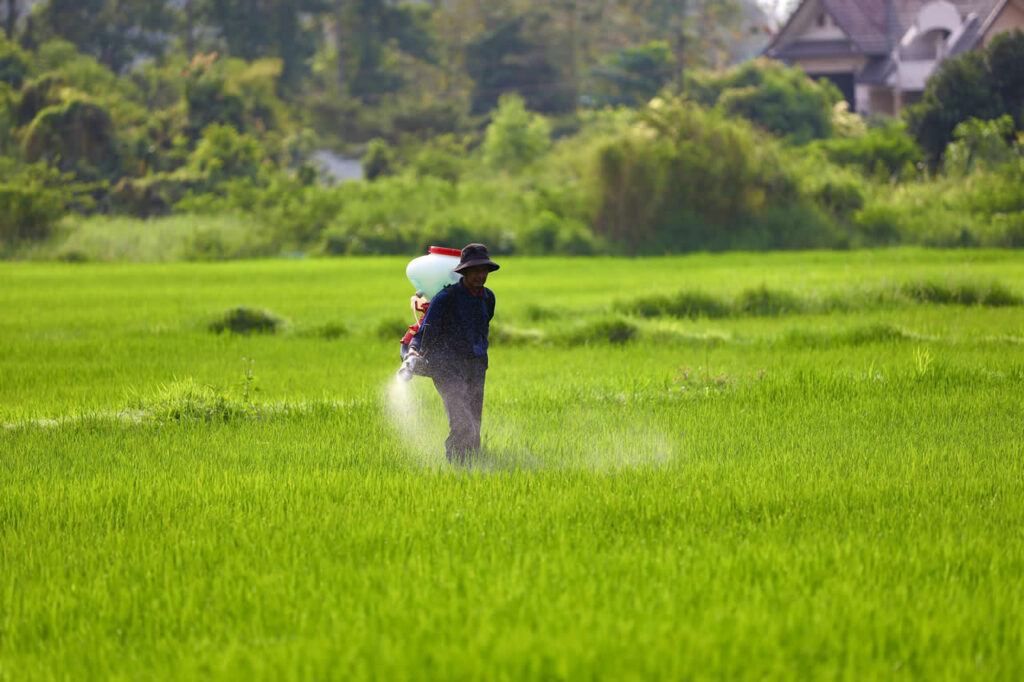
Common On-Farm Practices
- Tank-mix “cocktails”: combining multiple products to “cover everything,” sometimes at higher-than-label rates.
- Short re-entry intervals: harvesting or weeding soon after spraying due to tight schedules and labor constraints.
- Frequent herbicide use: herbicides dominate spend, especially in rice, sugarcane, cassava.
- Spray timing by pest sighting: reactive rather than threshold-based or calendar/IPM-based approaches.
- Container reuse: chemical jugs repurposed for water/fuel on some small farms (a key safety risk).
Why These Practices Persist
- Economics: chemicals are cheaper and faster than hiring labor for manual weeding or scouting.
- Market pressure: “perfect-looking” produce for buyers/exporters encourages more spraying.
- Access & advice: local agri-shops often act as de-facto advisers; extension services can be stretched.
- Credit & convenience: dealers extend credit and bundle inputs, locking in product choices.
- Heat & comfort: full PPE is uncomfortable; masks and gloves are inconsistently used.
Retail & Enforcement Realities
- Dealer density: pesticide retailers are common in farm belts; quality of advice varies widely.
- Label literacy: Thai labels exist, but small fonts/technical terms limit usefulness in practice.
- Informal supply: legacy stock and parallel imports can keep restricted actives in circulation.
Community Exposure Patterns
- Spray drift to nearby homes, schools, and shops—especially on windy days.
- Canal runoff during storms; shallow wells near fields face higher contamination risk.
- Residues on transport: pickups, motorbikes, and tools move residues between plots and villages.
📌 If you garden at home: buy only what you need, follow Thai labels exactly, wear nitrile gloves and eye protection, avoid decanting into drink bottles, and keep children/pets away from mixing/spray areas. Prefer lower-toxicity options or non-chemical controls when possible.
International Trade & Global Pressure
Thailand is one of the world’s top exporters of rice, seafood, fruit, and processed food. That global role means the way it uses pesticides isn’t just a domestic issue—it’s closely tied to international trade rules and consumer expectations abroad.
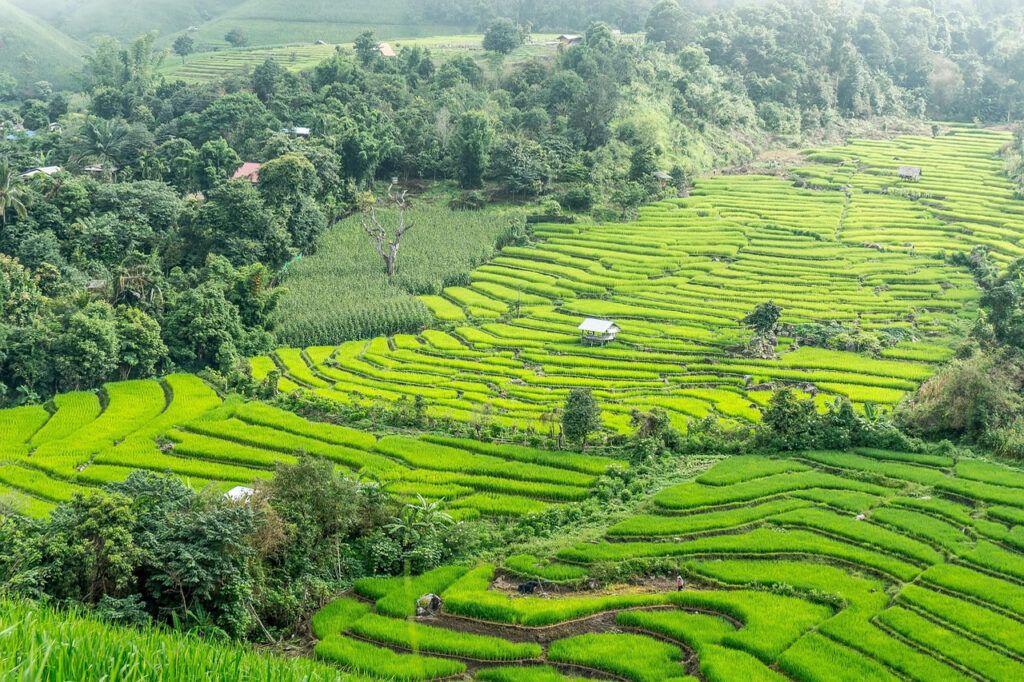
Export Standards and Inspections
- The European Union and United States apply strict limits on pesticide residues (Maximum Residue Limits, or MRLs).
- Thai produce shipments have occasionally faced rejection or recall when residues exceeded those limits.
- Exporters and cooperatives now pressure farmers to comply, offering training and stricter sourcing policies.
Trade vs. Domestic Reality
- For export-bound crops like jasmine rice, mangos, and longan, farmers are often pushed toward GAP certification and closer monitoring.
- Produce for local consumption, however, is under looser oversight, and residues above international standards sometimes reach domestic markets.
- This dual system reflects the economic reality: meeting international standards costs more, but farmers can’t always pass those costs on to local buyers.
Pressure from International Partners
- In 2019–2020, when Thailand moved to ban glyphosate, strong opposition came from US trade representatives, citing disruption to soybean and wheat imports.
- As a compromise, glyphosate was restricted rather than fully banned—showing how external pressure can shape Thailand’s pesticide policy.
- Similar tensions are expected in the future as global safety standards tighten further.
Export vs. Domestic Market: Pesticide Oversight in Thailand
| Market | Oversight | Common Practices |
|---|---|---|
| Export Market | Strict residue checks, GAP certification, tighter monitoring | Farmers receive training, use safer inputs, follow protocols more closely |
| Domestic Market | Looser oversight, random checks, weaker enforcement | Heavier reliance on older pesticides, frequent spraying, fewer protective measures |
Impact on Farmers
- Farmers producing for export often receive better training, more careful monitoring, and access to safer alternatives.
- Smallholders producing for domestic markets may rely on older practices, cheaper chemicals, and weaker enforcement.
- The result is a two-tier system: internationally competitive farms with improved standards, and local farms where pesticide use remains heavy and less regulated.
📌 What this means for expats: When shopping in Thailand, GAP-certified or organic produce in supermarkets is often held to the same standards as export crops. Wet market produce may not meet the same requirements, even if it looks just as fresh.
Alternatives & Solutions
Thailand’s heavy reliance on pesticides has raised red flags, but there are pathways forward. Both government agencies and grassroots initiatives are promoting safer, more sustainable farming methods that protect yields while reducing health and environmental risks.
Integrated Pest Management (IPM)
- Encourages farmers to use a mix of biological controls, crop rotation, and targeted spraying only when necessary.
- Training programs exist, though adoption remains uneven—often higher among export-focused farms.
- Benefits: lowers chemical use, reduces costs, delays pest resistance.
Organic Farming Movement
- Growing fast in regions like Chiang Mai, Hua Hin, and Prachuap Khiri Khan.
- Supported by cooperatives and local markets, with certification systems like “Organic Thailand.”
- Exports: Thailand has positioned itself as a supplier of organic jasmine rice, fresh herbs, and niche fruits.
- Challenges: higher costs, lower yields in early years, limited access to markets for smallholders.
Government & NGO Programs
- Ministry of Agriculture offers Good Agricultural Practice (GAP) certification to push safer standards.
- NGOs and universities run farmer field schools, teaching pesticide alternatives and safe handling.
- Pilot projects in community farming aim to supply urban consumers with “safe food” baskets.
Technology & Innovation
- Drones used for precision spraying, limiting farmer exposure and reducing chemical volume.
- Mobile apps offering pest alerts and dosage calculators (though adoption is mostly among younger farmers).
- Research into biological pesticides (plant extracts, fungi, bacteria) as replacements for synthetic chemicals.
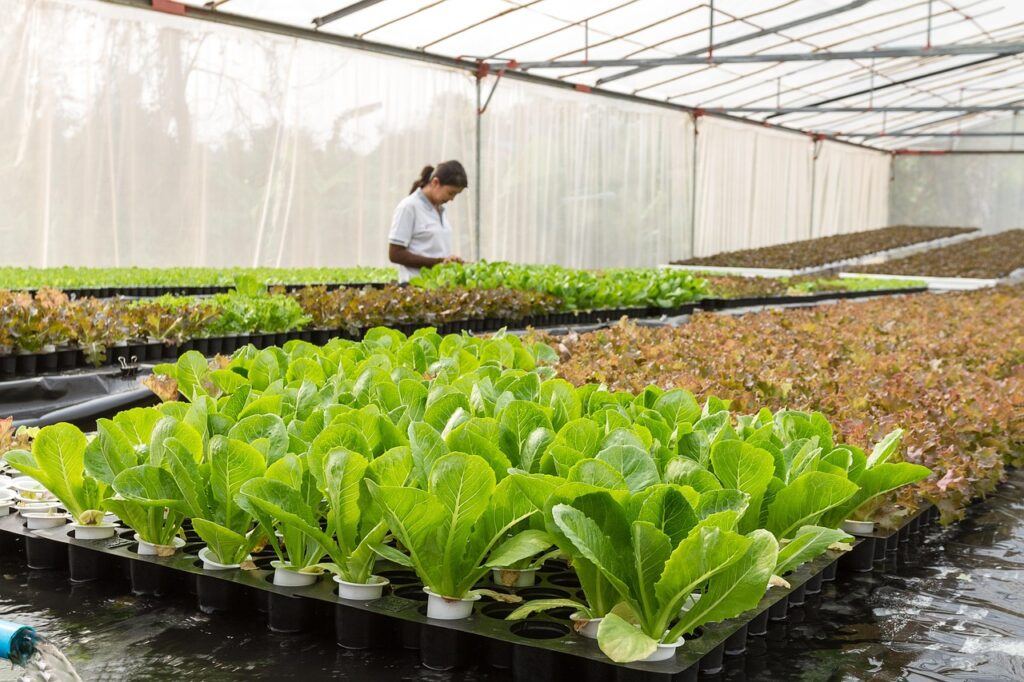
Pesticide Alternatives in Thailand: Pros & Cons
| Alternative | Pros | Cons |
|---|---|---|
| Integrated Pest Management (IPM) | Reduces chemical use, delays resistance, long-term cost savings | Requires training; slower adoption among smallholders |
| Organic Farming | Healthier produce, export niches, growing domestic demand | Higher costs, initial yield dip, certification hurdles |
| GAP Certification | Safer practices, export access, builds consumer trust | Compliance time/cost can be high for small farms |
| Tech & Bio-inputs | Precision spraying cuts exposure; bio-pesticides are eco-friendlier | Upfront costs; limited reach in rural areas |
📌 For Expats and Consumers: Supporting organic markets, GAP-certified produce, and farm-to-table initiatives helps drive demand for safer farming. Even small choices—like buying from community-supported agriculture (CSA) programs or organic sections in supermarkets—send signals that encourage change.
What This Means for Expats & Travelers
For most foreigners, pesticides in Thailand aren’t something you’ll see day-to-day, but they do matter. Whether you’re cooking at home, grabbing a pad krapow at a street stall, or shopping in a supermarket, the choices you make influence your exposure.
Key considerations:
- Street food and local markets are safe for most visitors, but washing produce well at home is smart.
- Supermarkets increasingly stock GAP-certified or organic produce.
- If you garden in Thailand, pesticides sold at agri-shops may be stronger than what you’re used to abroad.
Everyday Food Safety Tips for Expats in Thailand
| Tip | Why It Helps | Where to Apply |
|---|---|---|
| Wash & Soak | Rinsing leafy greens and herbs in water with baking soda or vinegar reduces residues | At home kitchens |
| Peel When Possible | Thick skins (cucumber, mango, papaya) hold most residues near the surface | Home cooking & fresh fruit stalls |
| Choose GAP/Organic | Certification means stricter monitoring and safer farming practices | Supermarkets & organic shops |
| Time Street Food | Hot cooked dishes reduce risks; avoid raw garnishes at unknown stalls | Street stalls & night markets |
📌 Practical takeaway: You don’t need to avoid Thailand’s amazing food culture—just make small, smart choices. Wash at home, peel when you can, and look for GAP or organic labels if you want extra peace of mind.
Future Outlook
Thailand’s pesticide landscape is changing, but not overnight. Expect gradual tightening rather than a sudden overhaul.
What’s likely over the next 3–5 years
- Stricter residue enforcement (selectively): Export chains will keep tightening first; domestic spot-checks will expand in urban centers where consumer pressure is highest.
- More GAP and “safe produce” programs: Supermarkets will scale house-brand “safe” lines; provinces with strong logistics (Bangkok, Chiang Mai, Chonburi) will lead.
- Targeted restrictions, not blanket bans: High-risk actives face tighter controls (permit-based imports, crop-specific rules) before any full prohibitions.
- Faster adoption of precision tools: Drones and metered sprayers spread via contractor services, reducing worker exposure and total chemical use—especially on rice and sugarcane.
- Organic as a steady niche, not a majority: Organic acreage grows, but economics keep most farms in mixed or transitional models (IPM + reduced sprays).
- Better farmer training via buyers: Export cooperatives, processors, and large retailers drive field schools and audits; smallholders outside those networks change more slowly.
- Data transparency creep: More QR/label systems and retailer apps that show farm origin, GAP status, and residue test results on select lines.
Key tensions to watch
- Yield vs. safety: Weather shocks (droughts, floods) can trigger spray “bounce-backs” as farmers protect crops.
- Trade pressure: Changes in EU/US MRLs or import rules can ripple quickly through Thai policies.
- Black-market leakage: As rules tighten, parallel imports and legacy stock can keep banned actives circulating without stronger border and retail enforcement.
What this means for readers
- Choice will improve: Access to GAP/organic options widens in big cities and tourist hubs.
- Prices may diverge: Certified produce and organic carry modest premiums; wet-market bargains continue with variable oversight.
- Practical habits still matter: Washing, peeling, and sourcing from trusted vendors remain your best everyday tools.
Frequently Asked Questions (FAQs)
Below are some common questions about pesticide use in Thailand—covering the everyday concerns expats, consumers, and visitors often raise.
📌 Why are some pesticides still available in Thailand even after being banned?
Because of uneven enforcement and cross-border smuggling. Banned chemicals can still circulate in rural markets despite legal restrictions.
📌 How can consumers in Thailand reduce pesticide exposure in their diet?
Practical steps include washing produce thoroughly, peeling when possible, and buying from trusted organic or GAP-certified sources.
📌 Which crops in Thailand tend to use the most pesticides?
High-value crops like fruits (durian, mango, longan), vegetables, and rice typically receive the most intensive applications.
📌 Are smallholder farmers more affected by pesticide risks than large farms?
Yes. Smallholders often lack training, protective equipment, or financial alternatives, making them more vulnerable to health risks.
📌 Is Thailand moving toward international alignment on pesticide regulations?
Progress is gradual. Export markets push higher standards, but domestic policy and enforcement lag behind global best practices.
Thailand’s relationship with pesticides is at a turning point. Heavy reliance has delivered short-term gains but also long-term costs—health risks, environmental damage, and global trade friction. The gradual shift toward safer practices, organic farming, and integrated pest management shows promise, but it’s not a quick fix.
For expats, travelers, and anyone with an eye on Thai agriculture, the key takeaway is balance: the system is changing, but unevenly. Some regions are leading the way with safer, more sustainable models, while others still lean on intensive chemical use.
The bigger picture? Thailand will likely continue its dual path—mainstream farmers using reduced but still significant chemical inputs, while niche growers move toward organic and export-driven standards. Watching how government policies, consumer demand, and farmer economics interact will reveal whether sustainability becomes the rule rather than the exception.
💬 Have you noticed differences in food quality between supermarkets and local markets in Thailand? Share your thoughts or experiences in the comments—I’d love to hear them.
